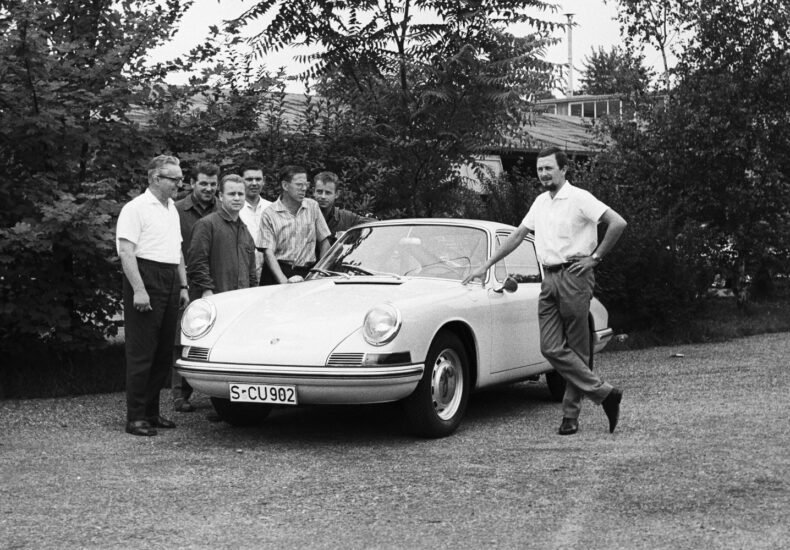
The Story of the Porsche 911
The story of the Porsche 911 began in the late 1950s. At the time, Porsche was still relatively new car manufacturer. The first Porsche production model, the 356 was unveiled in 1948. The 356 was a success, but it was aging and reaching the limits of its capabilities.
Idea of a New Sports Car
The new car had big shoes to fill. It had to be as good, or preferably better than the 356 in all areas. Customers wanted more luxury and comfort, and also more space for passengers and luggage. So the car needed to be larger and more powerful, but also as exciting to drive as the 356.
Deciding on the shape of the car was part of the body development process. Porsche didn’t have its own design department at the time, but many engineers and well-known designers had sent their proposals to Porsche. However, none of these got Ferry Porsche’s approval. After many different design studies, including a four-seater, Ferry’s son Ferdinand Alexander “Butzi” Porsche and his team created the historic design for the car.
The new car was a 2+2 seater with a hatchback on a unibody frame. Characteristic style elements included short overhangs, the distinctive headlight “tunnels” and the flat bonnet between them, and the large rear window. Like in the 356, the luggage compartment was at the front and the flat engine was situated at the rear. And to make the luggage compartment more spacious, the designers planned space-saving McPherson suspension at the front and the outdated swing axle was replaced by a semi-trailing arm suspension at the rear.
Flat-Six at the Rear
The new model was powered by a completely new six-cylinder flat engine with eight crankshaft bearings. Dry-sump lubrication ensured an adequate supply of oil, even at high longitudinal and lateral acceleration. One camshaft rotated in each of the cylinder heads, driven by intermediate shafts and a chain. With a compression ratio of 9:1, the 2.0-litre engine delivered maximum power output of 130 hp at 6,200 rpm. A newly developed five-speed transmission was used to transmit power to the rear wheels.
On the exhaust side, Porsche borrowed a tried-and-tested approach from the 356 in the shape of vehicle heating via heat exchangers. The heating pipes were routed into the sill boxes, with vents at the height of the footwell. The rear window and windscreen were supplied with hot air directly by defroster vents. In order to prevent any reduction in comfort compared to water-cooled vehicles manufactured by competitors, additional heating was provided as standard in the front of the 901.
Icon is Born
Porsche celebrated the world premiere of the 901 at the Frankfurt Motor Show on September 12 in 1963. However, this was only a pre-series vehicle. It was not until next spring when the new model could be presented to industry professionals. The series production started on September 14, 1964. The first vehicles were kept by the factory or used as exhibition vehicles.
One of them was sent to the Paris Motor Show. Everything seemed fine, when Porsche had an unexpected problem; the name of the car. Peugeot stated that they had been using three-digit numbers with a zero in the middle since 1929 and therefore owned the legal rights to all similar number sequences in France. Porsche’s sales management team suggested that the name should be changed from 901 to 911.
On October 22, 1964, Ferry Porsche gave the order for the name to be changed. From this day on, the 901 was called the 911. The icon was born.

You may also like
Latest Additions
- Race Car: Porsche 935 (2019)
 The limited-edition 2019 Porsche 935 clubsport racer pays tribute to the legendary Porsche 935/78 Le Mans race car
The limited-edition 2019 Porsche 935 clubsport racer pays tribute to the legendary Porsche 935/78 Le Mans race car - Michelin Pilot Sport S 5 – Great for Wet Conditions
 Track tyres are usually designed to provide optimal grip in dry conditions. For those drivers who don’t mind a little rain, the Michelin Pilot Sport S 5 is a perfect option for prolonging the track-day season. Michelin Pilot Sport S 5 Jointly developed by Porsche and Michelin, the Michelin Pilot Sport S 5 is a
Track tyres are usually designed to provide optimal grip in dry conditions. For those drivers who don’t mind a little rain, the Michelin Pilot Sport S 5 is a perfect option for prolonging the track-day season. Michelin Pilot Sport S 5 Jointly developed by Porsche and Michelin, the Michelin Pilot Sport S 5 is a - What is the 2023 Porsche 911 Sport Classic?
 The 2023 Porsche 911 Sport Classic is a limited-edition model with distinctive design cues inspired by iconic 911 models from history
The 2023 Porsche 911 Sport Classic is a limited-edition model with distinctive design cues inspired by iconic 911 models from history - Guards Red 2025 Porsche 911 GT3
 Red is a sports car color. But is red a GT3 color? You might say "yes" after checking these images of a Guards Red 2025 Porsche 911 GT3
Red is a sports car color. But is red a GT3 color? You might say "yes" after checking these images of a Guards Red 2025 Porsche 911 GT3 - 2021 Porsche 911 GT3 Cup (992.1) Specs
 Here are the technical specifications of the 2021 Porsche 911 GT3 Cup (992.1) racing car based on the 992.1 generation of the Porsche 911
Here are the technical specifications of the 2021 Porsche 911 GT3 Cup (992.1) racing car based on the 992.1 generation of the Porsche 911 - Race Car: Porsche 911 GT3 RSR (2011)
 For the 2011 season, Porsche unveiled a new version of the Porsche 911 GT3 RSR with extensive modifications
For the 2011 season, Porsche unveiled a new version of the Porsche 911 GT3 RSR with extensive modifications - 2025 Porsche 911 Carrera Cabriolet PDK (992.2) Specs
 Here are the technical specifications of the 2025 Porsche 911 Carrera Cabriolet (992.2) with the PDK transmission
Here are the technical specifications of the 2025 Porsche 911 Carrera Cabriolet (992.2) with the PDK transmission - 2025 Porsche 911 Carrera Cabriolet – 10 Fast Facts
 The 992.2 generation Porsche 911 Carrera Cabriolet was introduced for the 2025 model year. Here are 10 fast facts about the 2025 Porsche 911 Carrera Cabriolet
The 992.2 generation Porsche 911 Carrera Cabriolet was introduced for the 2025 model year. Here are 10 fast facts about the 2025 Porsche 911 Carrera Cabriolet - Porsche Design Chronograph 911 Turbo S (2025)
 Inspired by the new 2026 Porsche 911 Turbo S, Porsche Design has released a new Chronograph 911 Turbo S watch
Inspired by the new 2026 Porsche 911 Turbo S, Porsche Design has released a new Chronograph 911 Turbo S watch - 2026 Porsche 911 Turbo S – 10 Fast Facts
 The 992.2-generation Porsche 911 Turbo S is the most powerful production 911 to date. Here are 10 fast facts about the Porsche 911 Turbo S
The 992.2-generation Porsche 911 Turbo S is the most powerful production 911 to date. Here are 10 fast facts about the Porsche 911 Turbo S
